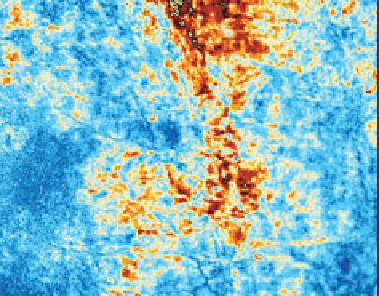Geoscience Reference
In-Depth Information
Single Azimuth full-offset RMS image
Multi Azimuth full-offset RMS image
Fig. A3.3
Comparison of a map view slice of the same interval from a single-azimuth
(conventional) towed streamer dataset and from a multi-azimuth dataset. The display on the right
shows improved signal to noise ratio and better fault imaging (This figure and
fig. A3.4
courtesy
BP exploration).
These methods have been developed primarily for deepwater application where there are restrictions
in the ability to deploy ocean bottom cables (OBC). This enables extension of wide azimuth techniques
that have been proved to be beneficial in shallow water through the use of OBC.
The cost of these surveys is greater than the cost of conventional seismic, with several passes of
the streamer boat over the same location being required to acquire the range of azimuths to image the
reflectors correctly. The trick is to optimize the acquisition design to keep the number of boat passes to
a minimum whilst ensuring that the data are of sufficient quality over the target interval.
Figures A3.3
and
A3.4
illustrate the data improvements that can be obtained by applying this greater acquisition
effort. The industry clearly thinks the cost-quality trade-off is worthwhile with several different
types of wide azimuth surveys currently underway including some multi-client surveys in the Gulf of
Mexico.
There are pros and cons to each of the above techniques. MAZ has an advantage in that the
processing is largely conventional and the acquisition easy to deploy being an extension of narrow
azimuth surveys. Each survey direction can be processed independently using standard tools and
techniques. A straight-forward stack of all the azimuthal images seems to work reasonably well
though there is active research into improving this. This technique is thought to be most suitable for the
short wavelength (small obstacle) imaging problem. The WATS technique requires novel processing
since the sampling is less uniform than in the MAZ case but it does have the advantage that the stack
is dominated by larger offsets and hence multiple suppression is largely accomplished through the
stacking process. WATS has a more diverse range of raypaths and because of this it is thought to
be most suitable for the large wavelength (large obstacle) problem such as that presented by salt
sheets.
These techniques are relatively new but further information is given by Moldoveanu & Egan



